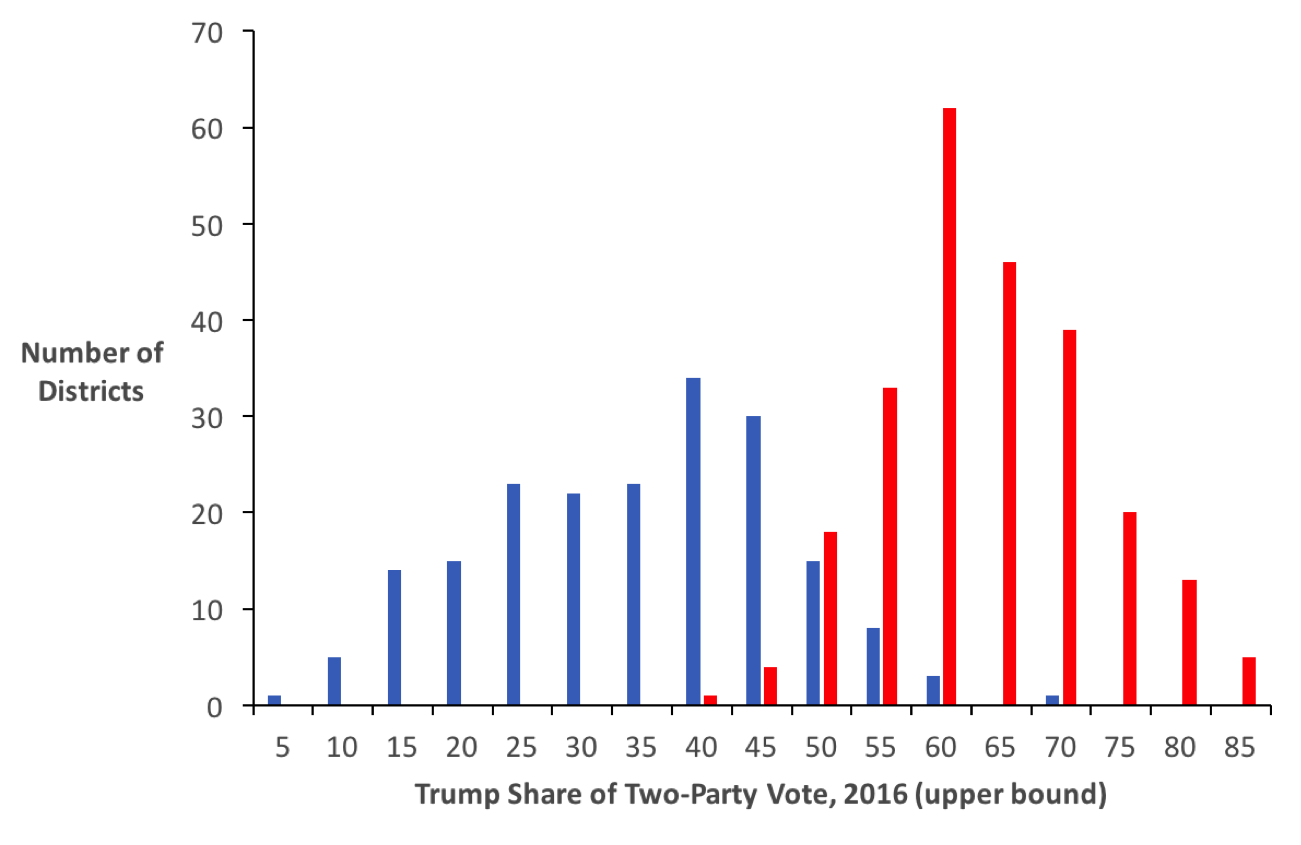Last week, I wrote a piece for Vox describing a simple mid-term election forecast model suggesting Democrats would win more than enough seats to take control of the House of Representatives. But in a world where districts are drawn to be less competitive, just how likely is this to happen?
It’s an important consideration, and not just because of gerrymandering. Districts are just becoming more politically stable. The number of very safe districts grew between 2012 and 2016—a period during which no redistricting took place—while the number of competitive districts shrank. Jurisdictions with fixed boundaries, including states and counties, are polarizing. So even if public opinion is moving in Democrats’ favor, do they still have a shot at flipping enough districts to seize the House? The short answer: yes.
An under-appreciated fact of the current Congress is that, despite the considerable polarization of districts, quite a few of them are still competitive. The histogram below shows the number of House seats held by Democrats and Republicans, distributed by Donald Trump‘s share of the two-party presidential vote in 2016:

As the chart shows, there’s considerable overlap between the parties in districts where Trump won between 40 and 60 percent of the vote. The most liberal district currently held by a Republican, in Florida, is represented by Ileana Ros-Lehtinen, who is retiring. Trump got just under 40 percent of the vote in her district. David Valadao, in California’s 21st district, and Carlos Curbelo, in Florida’s 26th, saw Trump get only 42 percent of the vote among their constituents. There are 20 Republicans representing districts where Trump got fewer votes than Hillary Clinton. It’s to these legislators’ credit that they managed to win in a pretty challenging environment, especially when Clinton got a slight edge in the popular vote nationally.
But 2018’s electorate won’t be like 2016’s. As Harry Enten noted in FiveThirtyEight, special elections in the year prior to a mid-term election are a pretty good predictor of how those elections will turn out (although there aren’t a ton of data points). By Enten’s analysis of the special elections in 2017, Democratic candidates have been out-performing their district’s partisan lean by an average of 12 points.
THE FUTURE OF REDISTRICTING IN AMERICA: How gerrymandering affected the 2016 election—and the solutions to help us move forward.
We don’t really know if such an advantage would apply to House races in a general election. But if it did, the damage to the GOP’s House majority would be pretty catastrophic. Just projecting a 10-point Democratic lean onto the histogram above, let’s focus on those districts where Trump got between 45 and 50 percent of the vote. The GOP won 18 of those 33 seats—a 55 percent success rate. But if there’s a 10-point swing in the Democrats’ direction, then Republican fortunes would be more like those districts where he got between 35 and 40 percent of the vote. In the latter, they won just one seat out of 35—a 3 percent success rate.
Similarly, project the districts where Trump received 55 to 60 percent support (where Republicans took 62 out of 65 seats) down to Trump getting 45 to 50 percent support. Republicans would only be expected to win 35 of those 65 seats. If we follow through on all of those brackets, we end up with Republicans losing 87 House seats, holding only 154 seats to the Democrats’ 281.
Republican losses aren’t likely to be nearly so large, mainly because that pretty much never happens. But even if there’s only a five-point shift in the Democrats’ favor, that would still suggest Republicans losing 40 seats (and the majority)—very close to what my economic forecast model suggested.
All of this is pure projection, of course. A lot can happen between now and November, and Trump’s and the GOP’s numbers have been trending slightly upwards in the past few weeks. But even if districts are safer than they used to be, quite a few of them are still quite competitive, more than enough to make a difference. The Republican redistricting wall is no stronger than the Blue Wall that was supposed to guarantee Democrats an Electoral College victory. If the tide rises high enough, a lot of districts will get flooded.





